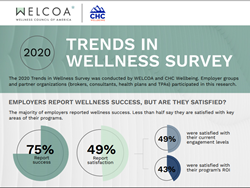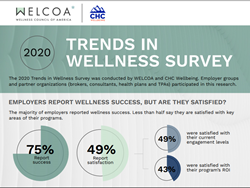[ad_1]

We see opportunity for companies who commit to a long-view for where they want wellness to take their organization over time.
CHICAGO (PRWEB)
September 10, 2020
Despite reporting success with wellness initiatives, employers are not yet satisfied with their efforts, based on findings from the 2020 Trends in Wellness Survey conducted by WELCOA and CHC Wellbeing. In total, 329 WELCOA members completed the survey, including 250 employer groups and 87 partner organizations (brokers, consultants, health plans and TPAs).
While 75 percent of employers believe their current wellness efforts are effective, only 49 percent were satisfied with their current engagement levels and only 43 percent were satisfied with their program’s ROI.
Companies reporting wellness success were 75 percent more likely to have clearly defined their “why” for wellness, 50 percent more likely to have a multi-year plan in place and 35 percent more likely to leverage data in the design and implementation of wellness programming.
Less than half (49 percent) of respondents reported having a thoughtful approach for measuring the impact of their efforts and only 46 percent had a long-term, strategic plan in place for their wellness initiatives. Employers are specifically struggling to support their high-risk populations. Fewer than one-in-three (28 percent) said they had an effective solution for engaging high-cost employees with chronic health conditions.
For those who believed their current wellness efforts were ineffective, more than half (55 percent) ranked low levels of engagement as their biggest challenge. The second most frequently cited issue was a lack of a strategic plan (35 percent).
The study was fielded just prior to the onset of the COVID-19 pandemic, but the research team believes the coronavirus has only further solidified the findings.
“What we have experienced with our clients over the last several months has echoed the key findings from this study, possibly even magnifying them,” said Ramki Ramanarayanan, CEO of CHC Wellbeing. “These results validate that how you bookend your program is just as important as the program itself. The strategy you start with, and the measurement approach to gauge your success, are just as important as the support you offer. Many organizations focus solely on implementation at the expense of strategy and measurement. That limits their impact.”
On a positive note, three out of four employers claim to have clearly defined what wellness means for their population and know “why” they are investing in wellness as an organization. A little over half (51 percent) reported using WELCOA’s 7 Benchmarks to design their program.
“We were pleased to see a majority of organizations are putting the fundamentals in place by defining their ‘why’ and taking advantage of the assessments and tools available through WELCOA,” said Sara Martin, CEO of WELCOA. “Where we see an opportunity is in extending this approach to build a plan for the next 3 years, taking a long-view for where they want wellness to take their organization over time.”
What’s New, What’s Next?
When asked to rank the three most important wellness priorities for the year ahead, employers and partners both named mindfulness/mental health as their top focus.
Employers
Mindfulness/mental health support: 63%
Wellness challenges and campaigns: 34%
Strategic planning: 31%
Targeted outreach for high-risk: 29%
Financial wellness: 23%
Partners
Mindfulness/mental health support: 58%
Strategic planning: 46%
Targeted outreach for high-risk: 28%
Financial wellness: 27%
Data Analytics: 26%
Employers, Partners Not Fully Aligned on Wellness Priorities
For the most part, employers and partner organizations were in alignment based on this research. In a few key areas, though, the two groups differed.
Half of partner organizations believed that achieving a financial ROI was the top wellness priority for their clients. Meanwhile only 9 percent of employers ranked ROI as their top priority. Instead, nearly half of employers (47 percent) said driving employee engagement was most important.
Another point of departure, approximately half of employers (49 percent) agreed that finding a comprehensive, one-stop-shop solution is more desirable than building a “best of breed” program using multiple vendors. Partner organizations were much more supportive of comprehensive providers, with 68 percent agreeing that a holistic solution trumps best of breed.
The Bigger the Better When It Comes to Wellness
The number of employers who report success with current wellness programs consistently increases with the size of the company. Employers with 100-250 employees were least likely to say their wellness efforts have been successful (65 percent). Meanwhile, the success rate was 66 percent for groups with 250-500 employees, 72 percent for those with 500-1000, 80 percent for those with 100-5000 and 82 percent for companies with more than 5,000 employees. Large companies were most satisfied with engagement levels (55 percent) but one of the least satisfied cohorts when it came to ROI (37 percent).
Blue Collar Groups Fall Behind Wellness Curve
When comparing various workforce types, blue collar employers were much less likely to report wellness success (63%) than white collar employers (78%) or organizations with a blended employee population (78%). Blue collar groups also were less likely to be satisfied with participant engagement and ROI and less likely to have a long-term plan in place for their wellness programming. Wellness priorities also differ for blue collar groups. They were far more likely to rank risk reduction as a top reason for engaging in wellness and more likely to use health data when designing wellness programming.
About the Study
The 2020 Trends in Wellness Survey is a joint research project led by WELCOA and CHC Wellbeing. This study examines current beliefs about, and experiences with, wellness programming. In total, 329 WELCOA members completed the survey, including 250 employer groups and 87 partner organizations (brokers, consultants, health plans and TPAs). Survey responses were collected between February 18 – March 8, 2020.
About WELCOA
WELCOA (The Wellness Council of America) is the nation’s most respected resource for building high-performing, healthy workplaces. Throughout its 30+ year history as a nonprofit, WELCOA has perfected its patented Well Workplace protocol which is the key to developing, delivering, and sustaining a healthy corporate culture. Today, over 30,000 workplace wellness practitioners, human resources professionals, business leaders and consultants rely on WELCOA for tools, trainings and its Premier Provider Network (PPN) partners to move their wellness programs forward.
About CHC Wellbeing
CHC Wellbeing goes beyond wellness to true potential, helping individuals excel in every facet of their lives: physically, emotionally, socially and financially. With a proven track record of serving over a thousand clients, our evidence-based wellbeing strategies reduce costs, improve productivity and nurture an environment where people do their best work. Learn how you can reach your true potential by visiting http://www.chcw.com.
[ad_2]

